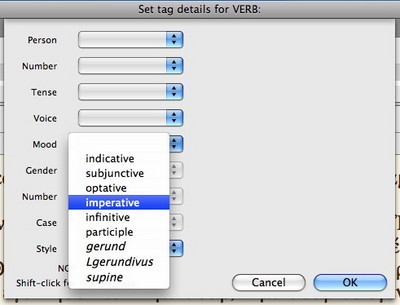In my previous post, I said that Accordance spares you having to learn a computer programming language in order to search grammatically-tagged Greek and Hebrew texts. That’s a very good thing considering how many real human languages pastors- and scholars-in-training are expected to tackle. Accordance’s search syntax is transparent and understandable even to the first semester student of Greek, something which is not necessarily true of other programs.
But perhaps that’s no big deal, since most programs offer some kind of simplified interface for choosing the various grammatical criteria to search. These simplified interfaces let you choose the criteria you want and then generate the proper search syntax for you. That being the case, who cares how transparent the search syntax is?
To answer that question, I’ll do a simple case study. In the process, I’ll demonstrate that even Accordance’s simplified interface is the simplest one around.
For our case study, we’ll search the Greek New Testament for all imperative verbs. Instead of typing [verb imperative], I’ll go to the Enter Grammatical Tag submenu of the Search menu and choose Verb. The following dialog box will appear:
As you can see, this dialog box gives me a clean and uncluttered listing of the various kinds of grammatical details which apply to verbs: tense, voice, mood, etc. I simply go to the appropriate menu and choose the form I want. In this case, I’ll go to the Mood pop-up and choose Imperative. When I click OK, the sheet is closed and the search argument [VERB imperative] is entered for me. I can then hit the search button to perform the search.
Now, contrast this with the simplified interface of another program. I choose to do a Greek Morphological search from a menu and get a large dialog box with quite a few checkboxes, fields, and pop-ups. To define my search, I need to scan the array of checkboxes to find the ones for verb and imperative. If I check Verb first the dialog closes those options which never apply to verbs, making it a little easier to find the section for Mood. Under the Mood section I see a checkbox for Imperative and check it.
If I try to click the Search button at this point nothing happens. I get no feedback that I have apparently done something wrong, but since nothing happened I begin scanning the dialog box for something I must have missed. Ah, there it is. Apparently I must first click the Add to Search button to force the dialog box to create the proper search syntax. When I do, I get the following cryptic search argument: [=V??M??]. When I perform the search, that same cryptic string of codes appears at the top of the results window, presumably so I’ll know what I searched for.
Because Accordance uses a transparent search syntax, I can see immediately what I am searching for: [VERB imperative]. I can also modify the search further without going through the dialog box. For example, I might add the word “second” to find second person imperatives or “aorist” to find aorist imperatives. If I have to modify V??M?? I have to know which question mark represents person and which represents tense, then I have to remember the correct abbreviation.
As you can see, not only is Accordance’s search syntax easier to understand and modify, its simplified search interface actually makes things simpler.
In my next post, we’ll look more closely at the Tag details dialog box to see how it scales from simple searches to more complex ones.


